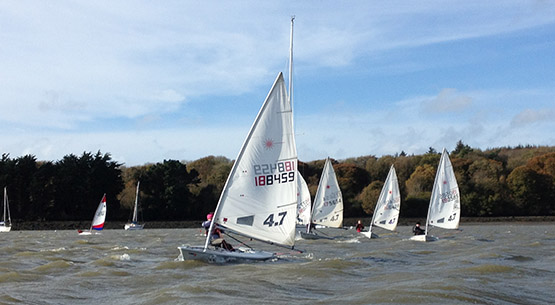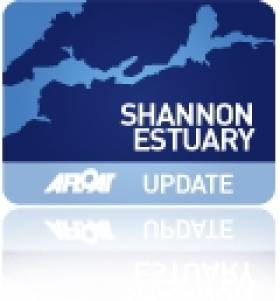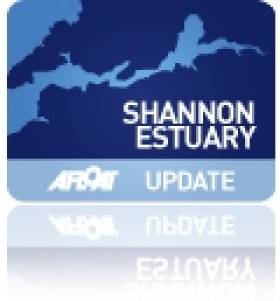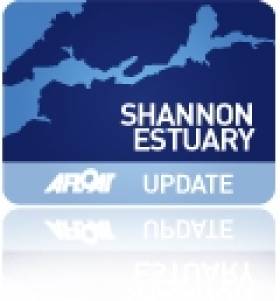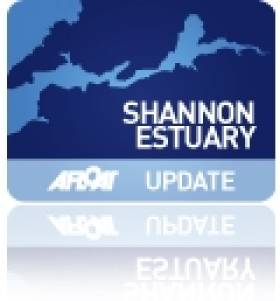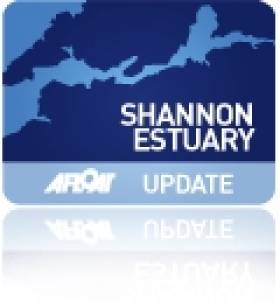Displaying items by tag: Shannon Estuary
'Unprecedented Opportunity' for Shannon Foynes Port As Trade Hub
#FoynesPort - An “unprecedented opportunity" for Foynes Port and the Shannon Estuary to become a centre of international trade with the potential for up to 3,000 jobs in the coming years, reports The Limerick Leader.
That is according to MEP Sean Kelly who is urging the European Union to recognise the port’s strategic importance.
The Fine Gael MEP recently attended a meeting in Brussels with port company chief executive Pat Keating and the European Commission’s Mobility and Transport Directorate.
“Shannon Foynes is one of a limited number of terminals with deep water facilities in Europe - facilities that no other Irish port enjoys. With the Panama Canal set to double its capacity in 2016, there is an unprecedented opportunity for Europe and for Ireland to capitalise as Shannon Foynes can cater for the huge new vessels that will be coming through,” said Mr Kelly.
To read more about the mid-western seaboard port, click here.
Kilrush RNLI Launch in Gales to Assist 43ft Motor Vessel
Kilrush RNLI Lifeboat crew on the Shannon Estuary launched early this morning in gale force conditions to assist 43ft motor vessel that had fouled its propeller south of Moneypoint.
At 4.59am Shannon Coast Guard tasked Kilrush RNLI volunteer lifeboat crew to assist a motor vessel with 3 people on board that had lost engine power due to its propeller becoming fouled.
Kilrush lifeboat crew reached the scene at 5.20am and assessed the situation. It was apparent that the motor vessel was heavily fouled and in no immediate danger of drifting. Commercial divers were tasked as the sea state improved and managed to clear the propeller. Kilrush RNLI stood by until power was restored to the motor vessel and returned to station at 7.10am.
Commenting on the callout, Charlie Glynn, Kilrush RNLI Lifeboat Press Officer said: ‘Weather conditions were challenging but our volunteer crews are well prepared for every eventuality. This is a testament to the level of training and commitment from all at Kilrush RNLI.’
First Dividend Paid by SFPC Amid Record Profits
#FirstDividend - Enjoying its biggest ever profits last year, Shannon Foynes Port Company (SFPC) has revealed from their 2014 annual report.
SFPC, which operates six ports on the Shannon Estuary and handles international trade valued at over €6bn, saw profits increase to €2.864m from €2.825m in 2013.
The company’s general cargo terminals recorded year-on-year increases of 5 per cent and capitalised on the recovering economy through a GDP growth of over 4 per cent for 2014.
The growth now means the company is in a position to provide a dividend from the 2014 results. For more on the story, The Sunday Business Post reports here.
Foynes Yacht Club Reports a Busy October on the Shannon Estuary
For the first time in its fifty three year history Foynes Yacht Club ran an ISA Go Racing course at the club during the school October mid-term break. The course was fully booked out with ten participants from Foynes Yacht Club, Dingle Sailing Club, Cullaun Sailing Club and Lough Derg Yacht Club who gave up their mid-term break lie-in to complete the course under the guidance of club racing instructor Tadhg O’Loingsigh and two senior Instructors, Simon McGibney from Foynes Yacht Club and Feidhlim O’Briain from Dingle Sailing Club. The weather was ideal for the course with the participants getting afloat every day in conditions varying from 5 knots to +25 knots. The junior sailors also had opportunities to hear from Graham Curran from UK McWilliam Sailmakers and international race officer Jack Roy, both of whom visited the club during the week. Foynes Yacht Club's Sailing Academy Principal Patrick Finucane said that the sailing academy has been striving towards this for a number of years and was delighted with the success of the course.
The cruiser October series took place during the month with a six race series and fourteen boats taking part. Racing took place over five weekends concluding on the final Saturday in October. The series started in beautiful sunshine with 10-12kts westerly where OOD Vincent McCormack set the fleet off with an interesting spinnaker start and following a course round the cans on the estuary. The next few week’s courses returned to beat starts either round the cans or windward leeward. Conditions were mixed, always sunshine, but winds anywhere from 5kts to 15kts, the lighter conditions presenting quite a challenge to anyone eager to get ashore on time for the rugby matches! Congratulations to the winners 1st Maximus from FYC, 2nd Scorpio Junior from Lough Derg, 3rd Powder Monkey from TBSC.
Junior and senior competitors after the ISA Go Racing course
The Laser and Topper fleet are back on the water again for the winter starting with a very successful October Series with nineteen boats taking part over the five weekends and nine out of the ten scheduled races taking place. Congratulations to the series winners in the senior fleet 1st Simon McGibney, 2nd Mark McCormack, 3rd Michael McGowan and in the junior fleet 1st Dylan Reidy, 2nd Mary McCormack, 3rd Oisín Finucane. The Laser and Topper November Series will begin next weekend and run on Sunday afternoons for the next four weeks.
#foynesairshow – One of the largest search and rescue (SAR) training exercises ever undertaken in Ireland will open the 2015 Foynes Air Show on Sunday, 26th July.
The Irish Air Corps, Naval Service (LÉ Samuel Beckett), Irish Coastguard, and Search and Rescue teams from all over the country will carry out their annual exercise in front of the estimated 15,000 people expected to attend the second annual air show.
Hosted by Foynes Flying Boat & Maritime Museum, the Air Show will also feature aircraft displays from across Europe, along with some of the world's top aerobatic pilots.
Among the aircraft taking to the skies over West Limerick and the Shannon Estuary will be a Russian Mini MiG, authentic World War Two aeroplanes, a Hawker Hunter fighter, a P51 Mustang and James Bond's BD-5 Micro-Jet. Meanwhile, Aer Lingus' first plane, the Iolar, will be flying in formation for one of the first times ever at a public display with three de Havilland Chipmunks in Air Corps colours.
The Air Show will also feature the world's only formation wingwalking display team, The Breitling Wingwalkers who will perform a sequence of formation loops and rolls while wingwalkers perform acrobatics on the wings.
The Air Show, which gets underway at 1pm and continues until 6pm, will also feature live music, food stalls and children's entertainment. Organisers say that Park and Ride services will be provided throughout the event to enhance access to and from the Air Show site
The Foynes Air Show was first held in 2014 when the Foynes Flying Boat & Maritime Museum marked the 75th anniversary of the first transatlantic commercial passenger flight that took place to the Flyingboat base, located 23 miles from Limerick City.
"We look forward to hosting a thrilling and exciting Air Show of an international standard which will feature even more aircraft and participants than our hugely successful inaugural show in 2014," commented Margaret O Shaughnessy the Director of Foynes Flying Boat & Maritime Museum.
"Foynes has a strong association with international aviation and has the world's only Flying Boat Museum featuring the world's only replica of B314 flying boat. The Air Show not only provides a wonderful day out for aviation enthusiasts and people of all ages but it also celebrates Foynes' historic place in world aviation history," she added.
Gerry Humphreys, Foynes Air Show Director said: "We are very excited to bring this free air show to Foynes again this year. We would like to thank our many sponsors without whose support this event would not be possible."
Aircraft taking part in the 2015 Foynes Air Show include:
Cold War Russian Aircraft - The Somerset-based Yakovlevs will perform a specialist airborne display team flying authentic cold war Russian war-bird aircraft in precise combinations of tight formations and aerobatics, high-speed passes and crosses.
BD5 - Made famous in the opening sequence of the James Bond film, Octopussy, the BD5 is a single-seat homebuilt aircraft created in the late 1960s by US aircraft designer Jim Bede
Sukhoi Su-26 - A single-seater aerobatics plane from the former Soviet Union, flown by ond of Ireland's top aerobatic pilots and engineers Dave Bruton
Hawker Hunter - A UK jet fighter flown by highly experienced former RAF Harrier pilot and Airbus Captain Andy Hill
Christen Eagle - Described as a true sports car of the sky, the 2-seat Eagle flown by Andrew Fenton will perform aerobatics
CAP 231 – Top Aerobstic Pilot Eddie Goggins "The Flying Dentist" returns to Foynes to fly an aircraft designed for competition aerobatics
Aviatika-MAI-890 (Mini-MiG) – 21 year old Pilot Harry Humphreys will fly his Aviatika-MAI-890, a pod-and-boom, pusher configuration biplane designed and built by the Moscow Aviation Institute (MAI) in Russia in the 1980s
RV4/8 - UK-based Team Raven will perform a 5-ship RV4/8 Aerobatic formation display
Vans RV7 - Gerry Humphreys and Eddie Goggins, known collectively as AerDynamics, are the first ever Irish civilian aerobatic formation team and will be flying the versatile Vans RV7 and the Cap 231 in a unique display of low level formation aerobatics and exciting head-on passes.
Killorglin based Approved Productions are the event managers for the upcoming Air Show, which is being supported and sponsored by Limerick City and County Council, The Irish Aviation Authority (IAA), Avolon, Wild Atlantic Way, Shannon Foynes Port Company, Irelandia Aviation, AerCap, Air Contractors, Rusal Aughinish and CPL Fuels.
EU Funding of €3m to Drive Shannon Foynes Masterplan
#EUPortFund - Funding of €3m from the EU has been secured for Shannon Foynes Port Company, the bulk of which will be spent on building a new East Jetty at the Limerick port, writes The Limerick Leader.
But some €800,000 has also been assigned to examine the feasibility of restoring the rail link to the facility. The East Jetty and the restoration of the rail link are part of the port company's 30-year master plan, Vision 2041. Earlier this year, a seven-year investment plan of €50m got underway and work began on developing the East Jetty which is expected to cost €12.5m.
The €3m funding has come under the Connecting Europe Facility, which has rolled out a record €13.1 billion investment plan for 276 transport projects across Europe. The port company was one of some 700 applicants for the fund and invested considerable time and effort in making the application.
The work on the East Jetty will completed in two phases. The first phase, which has begun, will involve the construction of a retaining wall along berth six, the removal of the existing viaduct and the infilling of 14,500 square metres behind berth six to create substantial new open quay storage.
Preliminary work will also take place on phase two, which involves linking the East and West jetties but construction of phase two is not expected to begin until 2019. The company has repeatedly made clear that it sees the restoration of the rail link as important for the continuing and future development of Foynes and of the estuary generally.
For more on the story click here
#foynesyachtclub – After a late start getting the boats launched, the members of Foynes Yacht Club made the most of the month of May on the water, despite the mixed conditions.
The sailing season kicked off with the annual Cruise to Limerick for the Limerick Riverfest on the May Bank Holiday weekend where 9 cruisers headed off to spend the weekend in the city. The oppie fleet travelled by road to meet them and the young sailors, aged 8 - 14yrs, braved the cold, rain & wind to go for a sail in the city. The cruise in company spent two nights in Limerick docks and had their annual catch up and a few drinks with the Inland Waterways Cruising Club and took in many of the activities going on for the Riverfest.
Commodore's Day was a family affair as Darragh McCormack took 1st place in IRC on his J24 Maximus, while his sister Mary won the dinghy race in the morning and followed that up with a win in the cruiser race in White Sails on their Dufour 35, Alpara. No nepotism involved, honestly! The Competent Crew Course run by Alan McEniff which started with a dry sailing evening in April with 16 participants continued throughout the month during the May Series on Wednesday evenings. Darragh kept the trophy cabinet full by also taking 1st place in IRC for the May Series while Tom Murray, who was relishing the heavy winds, was 1st in White Sails on his Kerry Sloop, Kerry Dream.
The Estuary Rugby Club had their end of year prize giving ceremony in the clubhouse early in the month. The young rugby players also got a taste of sailing as many of the cruiser fleet turned up to take them out in what started out a pleasant enough 15kts westerly before a squall bringing 35kt winds and lashing rain passed through. Luckily enough all the visiting crews were safely ashore by then. After a BBQ (& the rain), the point outside the clubhouse was turned into a rugby pitch for a game of tag rugby. The rugby club extended an invitation to the members for a follow up game at their club.... but I think I'de rather be out in the 35kt winds!!! The local St Senan's Youth Club also concluded their season by bringing about 70 youngsters down to the club for a sail around Foynes Island. For a change the sun peaked its head out & we had a lovely 12-15kts NW, just right for a nice leisurely sail & it was back to the clubhouse after that for another BBQ. Again, many thanks to all the boat owners who made their boats available and gave up their time to take our visitors out. These were two particularly enjoyable evenings in the club and it's great to see so much integration amongst the different clubs in the community.
The dinghy fleet returned to the club after participating in an April Series in Tralee Bay Sailing Club and the TBSC Spring Regatta in early May. FYC held its own Open Dinghy Event on the 3rd weekend in May in 15-18kts WNW breeze with 27 entries. 1st place for Adults in the Open Dinghy Fleet went to Tadgh O'Loinsigh from TBSC while Paddy Cunnane from DSC took 1st in the Junior fleet. 1st in the Oppies went to David McDaid from FYC.
The month concluded with the Munster Mermaid Championships. FYC will host the Mermaid National Championships in August so this was an opportunity for visiting boats to get some practice in local waters before the main event. There were 19 entries with three races scheduled over two days and as anyone who ventured out on the June Bank Holiday weekend knows, conditions were very challenging! Day one brought cold & very blustery 20-25kts winds gusting over 30kts and so the fleet was much depleted by day two which brought saw even stronger winds and even more nasty squalls! 1st place went to Paddy Dillon on Wild Wind (couldn't have been more aptly named!), Darragh McCormack (another trophy!) was 2nd on Innocence and Jim Carthy was 3rd on Vee.
Sailing will continue every Wednesday in June. First gun 1925. Let's hope for better and more consistent weather!
Kilrush RNLI Lifeboat In Multi-Agency Search Operation
#lifeboat – Lifeboat crew launched early this morning to take part in a multi agency search and rescue operation involving Kilrush and Fenit RNLI, Coast Guard rescue teams from Kilkee and Doolin.
At 3.29am Shannon Coast guard tasked Kilrush RNLI volunteer lifeboat crew to investigate a report of four persons in the water in the Poulnasherry Bay area of the Shannon Estuary.
Kilrush lifeboat crew were met by members of the public on the scene who had successfully recovered three persons safely from the water. The casualties were transferred by ambulance to Limerick Regional Hospital. Kilrush RNLI, Kilkee Coast Guard and the Shannon based Coast Guard helicopter undertook a large-scale search of the area to locate a fourth missing person.
The search operation continued through the night with the addition of Fenit RNLI lifeboat, Doolin Coast Guard, Irish Customs Vessel, Ballybunnion Rescue Services, SFPC Pilot Boat as well as an extensive shore search team from all agencies as well as navy diving units.
A person was recovered from the water at 10.42am following an extensive search.
Commenting on the callout, Pauline Dunleavy, Kilrush RNLI Lifeboat Operations Manager said: 'This was one of the largest search and rescue operation in the Shannon Estuary for a number of years. I would like to commend the quick response from all agencies especially the members of the public that assisted. On behalf of everyone at Kilrush RNLI Lifeboat Station, I wish to express our sincere condolences to the family and friends of the man who sadly did not survive.
Foynes Port Redevelopment Continues With Dredging Operations
#EastJettyInfill – Work on a major €50 million investment of Foynes Port that began in February to transform the Shannon Estuary port into one of the biggest bulk harbours in Europe continues with dredging operations, writes Jehan Ashmore.
The restructuring work of Foynes Port sees the redevelopment of the East Jetty which forms phase one of the work costing €12.5m towards the in-filling of 3.45 acres.
When completed this new open quay storage area will cater for 40,000dwt vessels to berth alongside to load and will enable improved bulk cargo discharge times.
According to Shannon Foynes Port Company, the Notice to Mariners No. 2 of 2015 states that the Jenny T, a suction dredger/dump barge is anticipated to carry out dredging and associated dumping works for approximately two weeks, dependent on weather conditions.Operations will be restricted to daylight hours only.
At the neighbouring West Jetty, this forms phase two of the project as this stretch of the Co. Limerick Port will be connected with the East Jetty.
The expansion of the port will add an additional 35,000 square metres of additional bertage and create more open quay storage at the port.
SFPC also plan over time to be able to accommodate 80,000 tonnes capacity vessels, the world's largest cargo vessels to unload at Foynes, making it one of the few ports in Europe capable of handling these massive ships. Currently these vessels transit the Panama Canal.
Union Chandlery Foynes Laser Spring Series Concludes
#shannonestuary – Foynes Yacht Club's dinghy fleet has been undergoing something of a revival in the past 6 months. For the first time in a number of years the club has continued sailing throughout the winter and has just concluded the Laser Spring Series which ran throughout February and March.
20 competitors in total took part over the 9 weeks with an average of 14 boats out each week. Given the mixed weather conditions at this time of year the fleet allowed for some flexibility with regard to racing on Saturdays or Sundays with aim of getting out on the water as many weeks as possible. The organising group made the call each Thursday evening and the result was racing 7 out of the 9 weeks and 16 out of the scheduled 18 races taking place. There were 5 new additions to the laser fleet this spring and they certainly didn't get the easiest introduction to dinghy racing. Huge credit goes to each of them, in particular the juniors as young as 14 years, for coming out every week.
They all agree they've pretty much mastered the skill of capsizing and righting the boat again at this stage!
At the prizegiving presentation Laser Class Captain Cathal McMahon thanked Union Chandlery in Cork, the main sponsors, for their generous prizes. He also thanked the OOD's & rescue crews and Reidy's Centra in Foynes & Clifford's Cash and Carry in Tralee for sponsoring the much appreciated soup and rolls after racing.
The club have been liaising with other clubs along the west coast to promote dinghy sailing and had a number of visiting boats from Tralee Bay Sailing Club for the series. As a follow on 10 boats from FYC have travelled to Tralee as they get their dinghy season up and running with an April Series running over the next four weeks.
FYC will also hold an Open Dinghy Regatta on Saturday May 23rd & Sunday May 24th and hope to see sailors from a few more clubs at what promises to be a 'competitive' but 'fun' event.


























